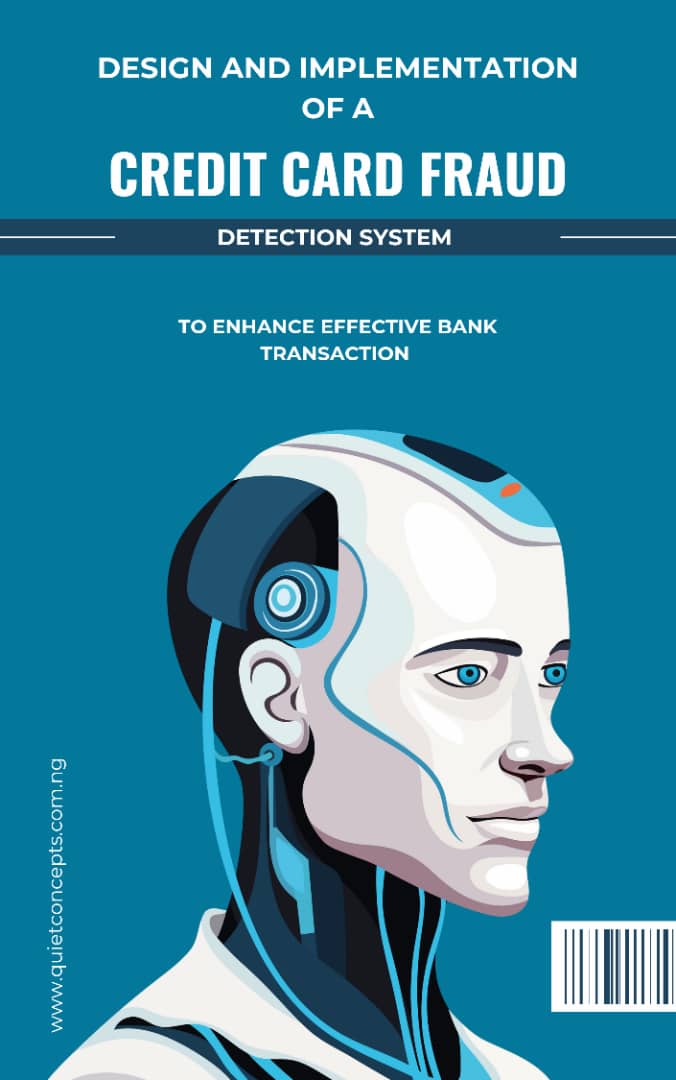DESIGN AND IMPLEMENTATION OF A CREDIT CARD FRAUD DETECTION SYSTEM TO ENHANCE EFFECTIVE BANK TRANSACTION
₦10,000.00 ₦3,000.00
PROJECT TOPIC: DESIGN AND IMPLEMENTATION OF A CREDIT CARD FRAUD DETECTION SYSTEM TO ENHANCE EFFECTIVE BANK TRANSACTION SYSTEM
PAGES: 68 PAGES
CHAPTERS: FIVE CHAPTERS
For further details, contact +2348039692804
Description
CHAPTER ONE
INTRODUCTION
- Background of the Study
The definition of fraud is difficult to be formed since the distinction between fraudulent and legitimate behaviours is not always obvious (Gosset, 1999). On the other hand, Alexopoulos (2007) define fraud as the deliberate and premeditated act perpetrated to achieve gain on false ground. The consequences of fraud are not restricted to economic losses but they can also lead to violation of human rights, physical and psychological harms as well as premature deaths (Friedrichs, 2009). Fraud can be perpetrated everywhere including financial institutions, insurance companies, corporations as well as the government.
Meanwhile, online transactions is increasing in our day to day life to purchase goods and services. According to Nielsen study conducted in 2007-2008, 28 of the world’s total population has been using internet. 85 of these people has used internet to make online shopping and the rate of making online purchasing has increased by 40 from 2005 to 2008. The most common method of payment for online purchase is credit card. In developed countries and also in developing countries, credit card is most acceptable payment mode for online and offline transaction. It can give financial loses to issuing authorities. In the second method purchasing i.e. online, these transactions generally happen on telephone or internet and to make this kind of transaction, the user will need some important information about a credit card (such as credit card number, validity, CVV number, name of card holder).
In our daily lives, credit cards are used for purchasing goods and services with the help of virtual card for online transaction or physical card for offline transaction. In a physical-card based purchase, the cardholder presents his card physically to a merchant for making a payment. To carry out fraudulent transactions in this kind of purchase, an attacker has to steal the credit card. If the cardholder does not realize the loss of card, it can lead to a substantial financial loss to the credit card company. In online payment mode, attackers need only little information for doing fraudulent transaction (secure code, card number, expiration date etc.). In this purchase method, mainly transactions will be done through Internet or telephone. To commit fraud in these types of purchases, a fraudster simply needs to know the card details. Most of the time, the genuine cardholder is not aware that someone else has seen or stolen his card information. The only way to detect this kind of fraud is to analyze the spending patterns on every card and to figure out any inconsistency with respect to the “usual” spending patterns.
Fraud detection based on the analysis of existing purchase data of cardholder is a promising way to reduce the rate of successful credit card frauds. Since humans tend to exhibit specific behaviorist profiles, every Card holder can be represented by a set of patterns containing information about the typical purchase category, the time since the last purchase, the amount of money spent, etc.
Delamaire (2009) defined credit card as a method of selling goods or services without the buyer having cash in hand. A credit card transaction involves four entities. The first entity is the consumer; that is the person who owns the card and who carries out the legitimate transactions. The second entity is the credit card issuer; that is usually the consumer’s bank – also known as issuing bank – which provides the credit services to consumer. The credit card issuer sends the bill to the consumer in order to request a payment for their credit card transactions. The third entity is the merchant who sells goods or services to the consumer by charging consumer’s credit card. This charge is achieved through merchant’s bank – the forth entity – which sends the request for the transaction to the issuing bank. The issuing bank will check whether the amount of the transaction does not reach the credit card’s limit before authorizing that transaction. If the transaction is valid the issuing bank will block the requested amount from consumer’s credit card account and send an authorization response to merchant bank. As soon as the authorization response is received by the merchant’s bank, the merchant is notified; the transaction is marked as completed and the consumer can take the goods. The blocked amount on consumer’s credit card account will be transferred into merchant’s bank account in the following days.
Although the use of credit cards as a payment method can be really convenient for our daily transactions; people must be aware of the risks that they impose themselves while using their credit cards. More precisely, the incremental usage of credit cards gave the opportunity to fraudsters to exploit their vulnerabilities. Credit card fraud refers to any illegal and unauthorized activity on the use of credit cards which is undertaken by a fraudster. According to Hand (2015), credit card fraud has been increased between 2005 and till date.
Although consumers are the least vulnerable in case of a credit card fraud there are states which enforce consumers to pay for the losses under particular circumstances. This happens in case the consumers do not realize that their credit cards have physically been stolen and fail to report the lost to their banks (Business Wire, 2013).
1.2 Statement of the Problem
It has already been mentioned that the losses of a credit card fraud can affect all consumers, merchants and issuing banks. Therefore, it is important to establish techniques for detecting and preventing credit card fraud. This research contains a variety of techniques which can be used to build fraud detection systems. Understanding the characteristics of all those techniques can be a tedious task. A technique which promises a high predictive accuracy may be an appealing candidate to be used in the fraud detection system. However, there are various different parameters that need to be considered before deciding which technique best suits the needs of a particular situation. And also as all the transaction is maintained in a log. And also now a day’s lot of online purchase are made so we don’t know the person how is using the card online, we just capture the IP address for verification purpose. So there is a need to develop a system to fight cyber -crime and to aid in investigating the fraud. To avoid the entire above disadvantage we propose the system to detect the fraud in a best and easy way.
1.3 Purpose of the Study
The general purpose of the study is to examine design and implementation of a credit card fraud detection system. Specifically, the study aims to:
- examine the method of reporting card fraud that happens
- assess the solutions provided for those that are victims of card fraud
- examine the tracking of fraudulent transactions to relevant agency
1.4 Research Question
- What are the methods of reporting card fraud?
- What are the solutions provided by banking agencies for the victims of card fraud?
- In what ways does banking agencies track those that engage in card fraud?
1.5 Significance of the Study
The findings of this study will benefit students, teachers, curriculum developers as well as the ministry of Education and future researchers.
Computer Science students will benefit from the findings of the study as the study will boost their innovative thinking on developing more systems on how to track fraud. It will also help them to develop more interest and skill in the use of computers which will facilitate the acquisition of knowledgeable skills such as sound societal values, norms and good attitude. The knowledge of their skill in computers will also help them to make proper career choice based on their capabilities on the use of computer assisted instructions.
The findings will motivate teachers to develop interest towards utilizing modern computer assisted instruction in teaching students to be more practical in computer approach.
Curriculum planners will also benefit from the study, since, the results of the study will assist in curriculum planning such as giving information relating to the teaching and learning of computer science can be utilized in appropriate strategies of curriculum planning, modification and revision.
1.6 Scope of the Study
The scope of the research is focused on implementing a credit card fraud detection system to compact the increasing cyber-crimes faced by our country. Geographically, the study will cover Federal College of Education (Special), Oyo as most of the students of the school are using credit card for transaction.
1.7 Operational Definition of Terms
– Credit Card – A credit card is a thin rectangular slab of plastic issued by a financial company, that lets cardholders borrow funds with which to pay for goods and services.
– Fraudulent – Obtained, done by, or involving deception, especially criminal deception.
– Verification –The process of establishing the truth, accuracy, or validity of something.
– Consumer- A person who purchases goods and services for personal use.
– Transaction- An instance of buying or selling something.
– Purchase- Acquire (something) by paying for it; buy.







Reviews
There are no reviews yet.